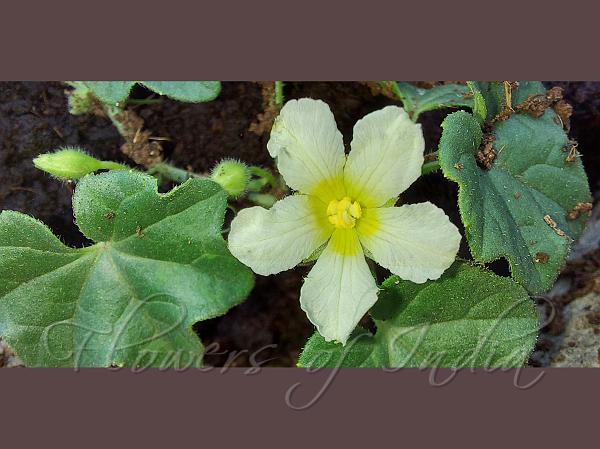|
| Little Wild Gourd |
|

|

| File size | 689808 |
| Original date | 6/27/21 7:14 AM |
| Resolution | 2576 x 1160 |
| Flash | Flash fired |
| Focal length | 2.13mm |
| Exposure time | 1/498s |
| Aperture | 2.4 |
| Focus Distance | |
| Metering Mode | Center weighted average |
| Camera make | samsung |
| Camera model | SM-M515F |
| Sensor type |
|
|
|
|
Photo: |
Botanical name: Momordica cymbalaria Family: Cucurbitaceae (Pumpkin family)
Synonyms: Luffa amara, Luffa tuberosa, Momordica tuberosa, Cucumis tuberosus
Synonyms: Luffa amara, Luffa tuberosa, Momordica tuberosa, Cucumis tuberosus
Little Wild Gourd is a perennial herb with slender,
climbing, branched, striped stem. It is a trailing plant with large
turnip shaped tuberous rootstock. The leaves are round-kidney-shaped in
outline, deeply heart-shaped at the base, bluntly lobed with 5-7 lobes.
flowers are white to yellow in color. Flowers are small, unisexual in
nature. The male flower flower-cluster-stalk is 5-30 mm long,
thread-like, hairy, ebracteate with 2-5 flowers in racemes with a pale
yellow flower and two stamens for each flower. The female flower is
solitary on a flower-cluster-stalk of 2.8 cm long. The fruits are
2.0-2.5 cm long, pyriform with 8 sharp ridges, 2.4 x 1.5 cm narrowed at
the tip and with the base narrowed into the curved
flower-cluster-stalk, which is fleshy, dark green and robbed. Seeds are
4.6 mm long, ovoid shaped, black, smooth and shiny. Little Wild Gourd
is found in Africa, Pakistan and India.
Medicinal uses: Little Wild Gourd fruits are
useful in treating gout, rheumatism and sub-acute cases of the spleen
and liver disease. The fruits juice and leaf tea of Little Wild Gourd
is employed for diabetes, malaria, colic, sores and wounds, infections,
worms and parasites, as an emmenagogue, and for measles, hepatitis, and
fevers. Fruit pulp, leaf juice and seeds possess antihelimetic
activity.
Little Wild Gourd fruits are
useful in treating gout, rheumatism and sub-acute cases of the spleen
and liver disease. The fruits juice and leaf tea of Little Wild Gourd
is employed for diabetes, malaria, colic, sores and wounds, infections,
worms and parasites, as an emmenagogue, and for measles, hepatitis, and
fevers. Fruit pulp, leaf juice and seeds possess antihelimetic
activity.
Medicinal uses:
 Little Wild Gourd fruits are
useful in treating gout, rheumatism and sub-acute cases of the spleen
and liver disease. The fruits juice and leaf tea of Little Wild Gourd
is employed for diabetes, malaria, colic, sores and wounds, infections,
worms and parasites, as an emmenagogue, and for measles, hepatitis, and
fevers. Fruit pulp, leaf juice and seeds possess antihelimetic
activity.
Little Wild Gourd fruits are
useful in treating gout, rheumatism and sub-acute cases of the spleen
and liver disease. The fruits juice and leaf tea of Little Wild Gourd
is employed for diabetes, malaria, colic, sores and wounds, infections,
worms and parasites, as an emmenagogue, and for measles, hepatitis, and
fevers. Fruit pulp, leaf juice and seeds possess antihelimetic
activity. | Identification credit: N Arun Kumar | Photographed in Aurangabad, Maharashtra. |
• Is this flower misidentified? If yes,